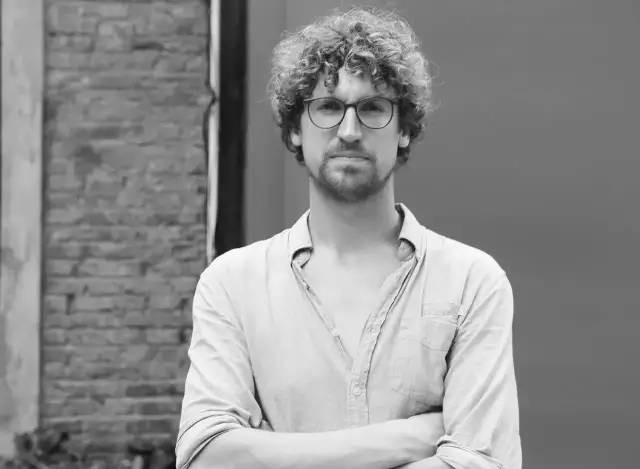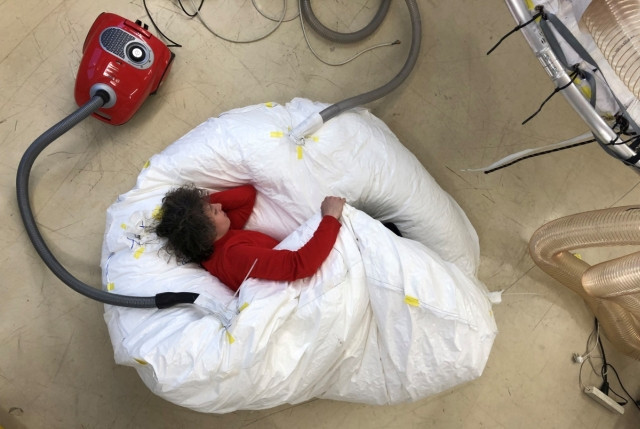
"Super handy and super boring for the body"
A few years ago Teun Vonk got stucked between two metro doors and the moments which he spent there turned his art into a brand new direction: instead of photography he started focusing on the human body and its surroundings. He created installations to discover how gravity works or how a dynamic space would look like if it engages to our body. The Dutch artist debuts his newest project, Enfolding Space on the rooftop of Art Quarter Budapest, on 18 of May in the frame of smART! XTRA 40. // Wonderlands event.
You started your career as a photographer but after a strange accident in Shanghaieverything changed…
Honestly, I am not interested in photography anymore. I started making movies but I realized that I don’t want to make work what you can see on the internet. You just get it from a screen but it is disconnected from your body. I was done with that, I wanted to do something else.
Few years ago, I was in Shanghai, which is a very crowded city and I felt very disconnected there. But I had a physical experience: I was squeezed between two metro doors, I got all the pressure on my body before I stepped out. Might sound strange but I loved that feeling. I was really stressed, but after this small accident, I felt more connected with my body and my surroundings. I really liked the physical aspect about that, so I wanted to reproduce it, to create the same experience on an abstract way. The pressure, the sedation, the stress.
But in some terms it might be quit close to photography. When you take a photo you use the camera to reproduce a moment. You have a device to create a moment. My machines are doing the same: they are based on my personal experiences, which I want to show in my art works. But I don’t like photography anymore, I almost hate it.
Photography cannot be interactive while in your installations people are involved. Is it the reason why you hate photography now?
Yes, photography is a passive way of art. I don’t like it, because we do it a lot. People are sitting behind a computer whole day and I am done with that. I wanted to create a real-life experience.
And the culture of images might be harmful too. If you are photographing the whole day, you experience your whole reality through a camera. You’ll be a tourist in your own reality. You are not present, your body is passive. I want to make something where people can feel their body and they can focus on their physical existence.
You mentioned that the accident helped you relieving stress. Can we say that your art installations are therapeutic?
I get this question a lot. I create my work for normal, healthy people. I want to show them what we can discover, what we can feel through our body. It can be therapeutic but it’s not my main goal. I want to make very interesting machines, which surprise people, and it influences their body.
By the way, I am going to collaborate with a group who are dealing with depressed people. They asked me if I can make something for them, so you might be true with this question.
Honestly I have built some machines which are even stressful. I am interested in the effect, nevermind how does it feel.
What does physicality mean in your art? What does it mean to you?
Good question, it’s wide. I can’t define what does it mean to me but I am searching for the answer in my works. What does it mean to have a body? What can we do with it? How does our surroundings relate to it? Our daily environment is designed to us: our cars, our buildings, our rooms. Even the fence, what is designed to keep you out.
How would an ’ideal space’ look like for you? For example your room or your office?
It wouldn’t look like a box. I am not an architecture and I am a terrible interior. But for sure my room wouldn’t be a square with flat walls and flat floor. Maybe in an office it is efficient to have flat walls but in my bedroom or living room, I don’t think it is necessary.
And Netherland is a very flat country that’s why we cycle a lot. Super handy and super boring for the body. I want to step on things and climbing on mountains. I really love the mattresses in the gym. They are soft and they move while you walk on them.
Let’s talk about your new installation, Enfolding Space. What inspired it?
Actually the same thing what we were talking about previously. I was thinking about how it would be if we could form space with our own body. Not with machines, drills and hammers but just with the entire body. Can you make a wall with yourself? That was my question.
Enfolding Space will debut in Budapest. We are still experimenting; I am super curious how people will react. It is only a small prototype yet, a process, which will help me take the next step. The final aim is to have an immersive material, which is all around the user. I am interested in the feedbacks.
Who helped you to create the installations?
In the beginning, I am the only one, who is doing the stuff in the studio and in a half year, when the form is ready, I will ask a professional seamstress to make it more accurately. But this time the whole project changes fast. Sometimes designers helping me out with technical things. We are not yet on the point when lot of people are involved.
What plans do you have with Enfolding Space? Will you install it in on other festivals?
It is very uncertain yet but I am open to any opportunities. I think I can answer this question when I have more experiences with the prototype and I got feedbacks from people. That’s the most exciting part of my work, I got a lot of energy from experimenting.
The best way to keep your JS files tidy is using the free online JavaScript formatter program.



















